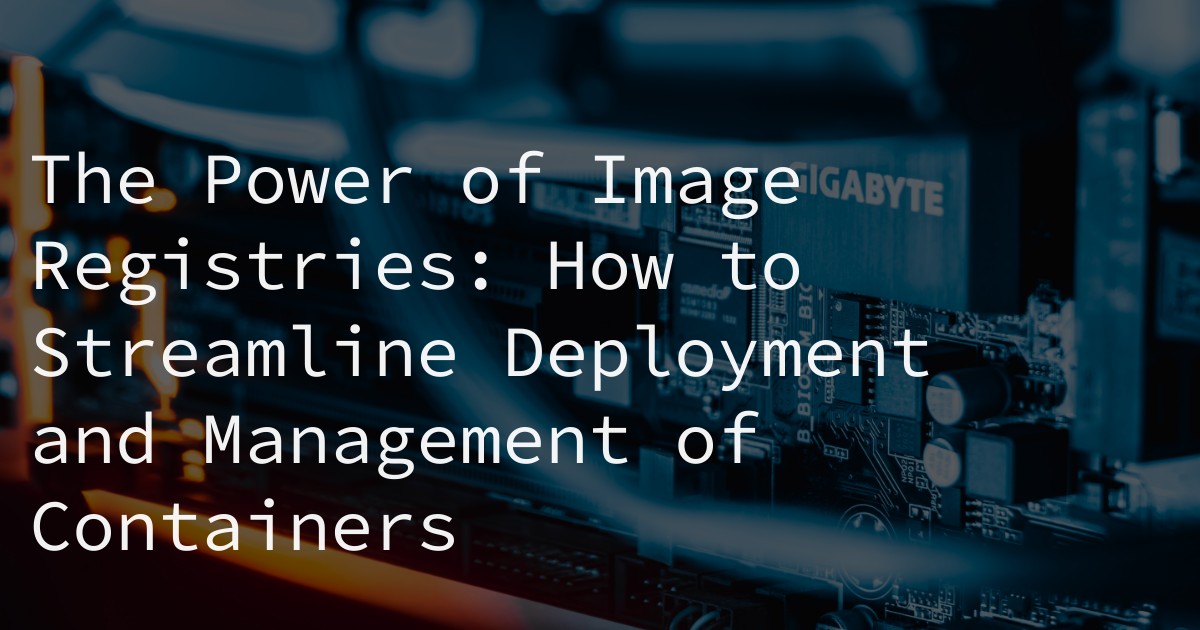
08 Nov The Power of Image Registries: How to Streamline Deployment and Management of Containers
The use of containers in cloud computing and cloud-native computing has revolutionized the way applications are deployed and managed. However, with the increasing complexity of containerized environments, it has become crucial to have efficient tools and processes in place to streamline deployment and management. This is where image registries come in. In this article, we will explore the power of image registries and how they can optimize and automate the deployment and management of containers, making it easier for organizations to adopt cloud-native technologies.
Overview of image registries
Image registries are repositories that store container images, which are used to create and run containers. These registries act as a central hub for storing, organizing, and distributing container images. They play a crucial role in cloud computing and cloud-native computing, as they enable organizations to easily deploy and manage containers in a scalable and efficient manner.
Some popular image registry options include Docker Hub, Google Container Registry, and Amazon Elastic Container Registry. These registries can be either public or private, with private registries providing additional security and control over the images.
Benefits of using image registries in container deployment and management
- Centralized storage and distribution of container images
- Efficient and scalable deployment of containers
- Version control and management of container images
- Streamlined collaboration and communication among teams
- Integration with other tools and processes for automation
Image Registries in Container Deployment
Simplifying deployment with image registries
One of the main benefits of using image registries is the ease of deployment they provide. With registries, organizations can easily pull images from the repository to create containers, and push images back to the registry after making changes. This simplifies the deployment process and reduces the risk of errors.
Moreover, image registries also allow for the management of different versions of container images. This is particularly useful in cases where updates or rollbacks need to be made, as organizations can easily switch between different versions of the same image.
Some popular image registry options for public registries include Docker Hub and Quay.io, while private registries include Harbor and Azure Container Registry.
ALSO READ
Automating container deployment with registries
Image registries can also be integrated into CI/CD pipelines to automate the deployment of containers. This allows for faster and more efficient deployment, as well as the ability to continuously update and improve container images.
Additionally, registries can also be used for infrastructure as code, where the configuration of containers is defined and managed through code. This enables organizations to easily replicate and scale their container environments.
Optimization and Automation Tips
Optimizing container images for registries
To ensure efficient deployment and management of containers, it is important to optimize the images stored in registries. This includes reducing the size of images for faster deployment and optimizing for efficient resource usage.
Best practices for organizing and tagging images in registries should also be followed to ensure easy identification and management of images.
ALSO READ
Automation tips for image registry management
To further streamline the management of image registries, organizations can implement automation processes. This includes setting up automated builds and tests, implementing automated security scans, and using registries for automated rollbacks and updates.
Streamlining Processes with Image Registries
Using image registries for monitoring, logging, and tracing
Image registries can also be integrated with monitoring tools for real-time insights into the performance of containers. This allows for better tracking of changes and identifying any potential issues.
Additionally, registries also offer logging and tracing capabilities, which are crucial for troubleshooting and debugging containerized environments.
Managing networking and storage with image registries
Image registries can also be used to manage networking and storage configurations for containers. This includes setting up network and storage options through the registry, as well as using registries for efficient data management and persistence.
Moreover, incorporating registries into a container orchestration platform, such as Kubernetes, can further enhance the management of networking and storage for containers.
Security and Image Registries
Implementing security measures with image registries
As with any technology, security is a crucial aspect to consider when using image registries. Organizations should implement authentication and access control measures to secure their registries, as well as regularly scan images for vulnerabilities.
Best practices for maintaining secure image registries should also be followed, such as regularly updating images and implementing secure coding practices.
DevOps, DevSecOps, and FinOps with Image Registries
Incorporating image registries into DevOps workflows
Image registries can greatly benefit DevOps teams by streamlining processes and reducing deployment time. They also allow for better collaboration and communication among team members, as well as integration with other tools and processes.
However, implementing registries in DevOps teams may also come with challenges, such as ensuring consistency and compatibility across different environments.
Implementing DevSecOps with image registries
With the increasing importance of security in the software development process, organizations can also incorporate image registries into their DevSecOps workflows. This involves integrating security measures into the deployment process, such as automated security scans and continuous monitoring.
Using image registries for FinOps
Image registries can also be used for FinOps, which focuses on optimizing costs in cloud computing. By monitoring and tracking the costs of image usage, organizations can implement cost optimization strategies and better manage their cloud expenses.
Conclusion
In conclusion, image registries play a crucial role in streamlining the deployment and management of containers in cloud computing and cloud-native computing. By simplifying deployment, automating processes, and enhancing security, registries enable organizations to adopt and scale their use of containers more efficiently. With the increasing adoption of cloud-native technologies, image registries will continue to play a vital role in the future of software development and deployment.
RELATED ARTICLES:



Sorry, the comment form is closed at this time.